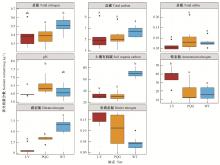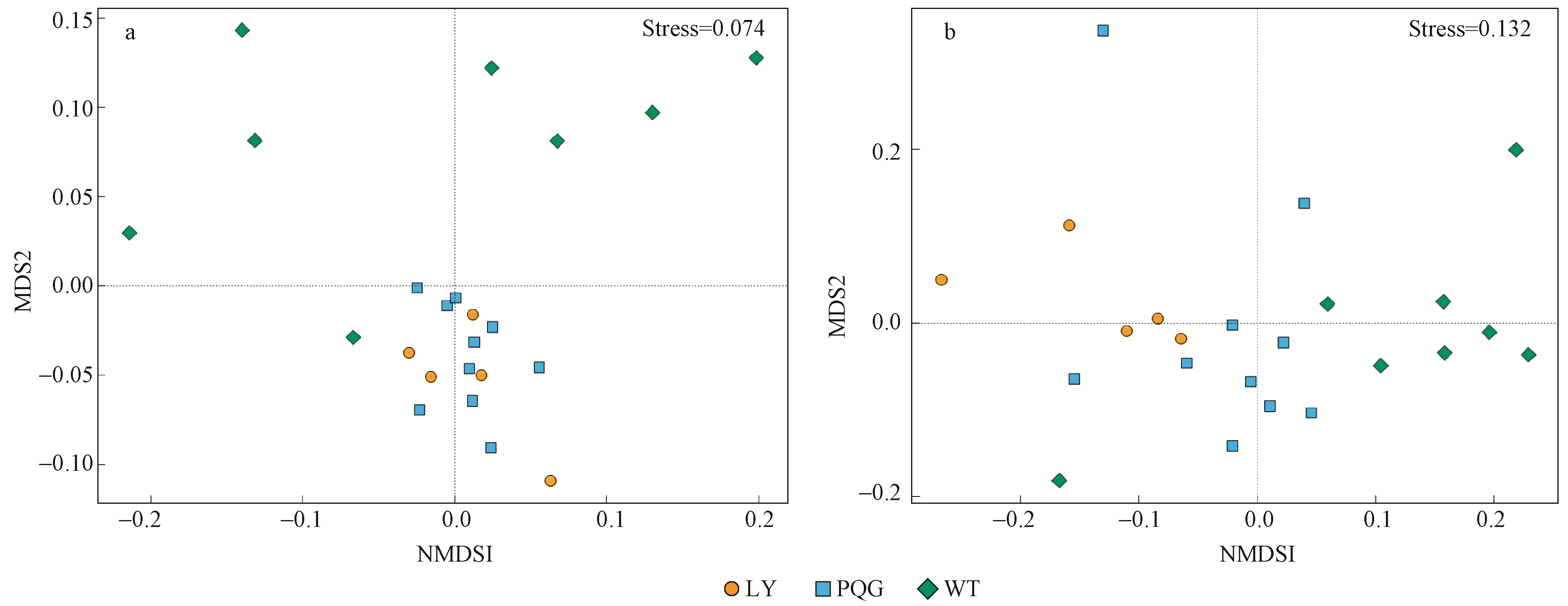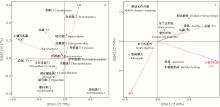

Scientia Silvae Sinicae ›› 2021, Vol. 57 ›› Issue (7): 101-110.doi: 10.11707/j.1001-7488.20210711
Previous Articles Next Articles
Pengyu Zhao1,Xue Bai1,Pingmei Yan1,Xiaodong Zhao1,Xiaoying Wu1,Baofeng Chai2,*
Received:2020-09-17
Online:2021-07-25
Published:2021-09-02
Contact:
Baofeng Chai
CLC Number:
Pengyu Zhao,Xue Bai,Pingmei Yan,Xiaodong Zhao,Xiaoying Wu,Baofeng Chai. Responses of Soil Bacterial Community Structure and Phenotype to Soil Heterogeneity in Larix principis-rupprechtii Forest[J]. Scientia Silvae Sinicae, 2021, 57(7): 101-110.
Table 1
The location of sampling plots"
| 样地 Plots | 站点 Sites | 海拔 Elevation/m | 纬度 Latitude(N) | 经度 Longitude (E) |
| LY1 | LY | 2 297 | 38°59′7.2″ | 112°4′19.2″ |
| LY2 | LY | 1 950 | 38°52′26″ | 112°0′1″ |
| LY3 | LY | 2 692 | 38°48′49.2″ | 111°51′31.8″ |
| LY4 | LY | 2 554 | 39°0′28.2″ | 111°53′16.8″ |
| LY5 | LY | 2 432 | 38°55′25.8″ | 112°7′25.2″ |
| PQG1 | PQG | 2 649 | 37°53′15.36″ | 111°32′44.10″ |
| PQG10 | PQG | 1 982 | 37°52′54.4″ | 111°35′25.8″ |
| PQG2 | PQG | 2 652 | 37°53′8.27″ | 111°32′45.84″ |
| PQG3 | PQG | 2 570 | 37°53′5.66″ | 111°32′46.02″ |
| PQG4 | PQG | 2 685 | 37°53′2.58″ | 111°32′7.65″ |
| PQG5 | PQG | 2 671 | 37°52′57.91″ | 111°32′7.99″ |
| PQG6 | PQG | 2 613 | 37°52′55.88″ | 111°32′11″ |
| PQG7 | PQG | 2 400 | 38°1′54″ | 111°31′06″ |
| PQG8 | PQG | 2 227 | 38°1′9″ | 111°31′16.8″ |
| PQG9 | PQG | 2 135 | 37°55′43.8″ | 111°31′19.2″ |
| WT1 | WT | 3 055 | 39°5′22.8″ | 113°35′34.2″ |
| WT2 | WT | 3 040 | 39°18′40.8″ | 113°37′31.8″ |
| WT3 | WT | 3 030 | 39°18′37.2″ | 113°35′55.8″ |
| WT4 | WT | 2 976 | 39°18′48″ | 113°34′12″ |
| WT5 | WT | 2 900 | 39°18′51″ | 113°37′34.8″ |
| WT6 | WT | 2 891 | 39°18′51″ | 113°39′40.8″ |
| WT7 | WT | 2 500 | 39°6′33″ | 113°56′35″ |
| WT8 | WT | 1 900 | 39°6′6″ | 113°57′26″ |

Fig.1
Soil physicochemical properties at different sampling sites Different letters mean the significant difference (P>0.05) for soil physicochemical properties at different sites. WT: Yedoufeng of Wutai Mountain; PQG: Pangquangou Nature Reserve of Guandi Mountain; LY: Luya Mountain. The same below."


Fig.4
NMDS analysis(Non-metric multidimensional scaling; NMDS) of bacterial community(a) and phenotype(b) at sampling sites Points of different colors or shapes represent samples in different groups. The closer the two sample points are, the more similar the species composition of the two samples. The abscissa and ordinate indicate the relative distance and have no practical meaning. Stress: Test the pros and cons of the NMDS analysis results. It is generally considered that it is available when stress < 0.2, and its graphics have a certain explanatory significance."


Fig.5
Redundancy analysis(RDA) reveals the relationship between soil physicochemical properties and soil bacterial communities The horizontal and vertical coordinates in the figure indicate the degree of explanation of the soil environmental factors to the bacterial community structure(a) or phenotype(b). The arrow in the figure indicates the environmental factor, and the length of the arrow line indicates the degree of correlation between the environmental factor and the bacterial community structure(a) or phenotype(b). The longer the line, the greater the correlation, and vice versa.. The angle between the line of the arrow and the sort axis and the line of the arrow indicates the correlation. The smaller the angle, the higher the correlation. An acute angle indicates a positive correlation, and an obtuse angle indicates a negative correlation."

| 段鹏, 张永超, 王金贵, 等. 青藏高原高寒湿地退化过程中土壤微生物群落功能多样性特征. 草地学报, 2020, 28 (3): 759- 767. | |
| Duan P , Zhang Y C , Wang J G , et al. Functional diversity of soil microbial communities during the degradation of alpine wetlands on the Qinghai-Tibet Plateau. Acta Grasslanda, 2020, 28 (3): 759- 767. | |
| 李毳, 马转转, 乔沙沙, 等. 原位微宇宙法研究温带森林土壤真菌群落构建的驱动机制. 生态环境学报, 2018, 27 (5): 23- 29. | |
| Li C , Ma Z Z , Qiao S S , et al. In-situ microcosmic method to study the driving mechanism of soil fungal community construction in temperate forests. Acta Eco-Environmental Sciences, 2018, 27 (5): 23- 29. | |
| 刘彩云, 王春强, 张丽辉, 等. 雨久花种群开花期生殖株构件表型可塑性及生长分析. 分子植物育种, 2020, 18 (7): 2366- 2370. | |
| Liu C Y , Wang C Q , Zhang L H , et al. Phenotypic plasticity and growth analysis of reproductive plant modules in Yujiuhua population during flowering period. Molecular Plant Breeding, 2020, 18 (7): 2366- 2370. | |
| 乔沙沙, 周永娜, 刘晋仙, 等. 关帝山针叶林土壤细菌群落结构特征. 林业科学, 2017, 53 (2): 89- 99. | |
| Qiao S S , Zhou Y N , Liu J X , et al. Soil bacterial community structure characteristics of coniferous forest in Guandi Mountain. Scientia Silvae Sinicae, 2017, 53 (2): 89- 99. | |
| 王瑞宏, 贾彤, 曹苗文, 等. 铜尾矿坝不同恢复年限土壤理化性质和酶活性的特征. 环境科学, 2018, 39 (7): 3339- 3348. | |
| Wang R H , Jia T , Cao M W , et al. Characteristics of soil physical and chemical properties and enzyme activities of copper tailings dams with different restoration years. Environmental Science, 2018, 39 (7): 3339- 3348. | |
| 王文晓, 程浩, 徐玉凤, 等. 带叶兜兰5个野生居群表型多样性分析. 植物遗传资源学报, 2020, 21 (5): 1196- 1206. | |
| Wang W X , Cheng H , Xu Y F , et al. Phenotypic diversity analysis of 5 wild populations of Paphiopedilum hirsutissimum population. Journal of Plant Genetic Resources, 2020, 21 (5): 1196- 1206. | |
| 王小艺, 杨忠岐, 魏可, 等. 昆虫翅型分化的表型可塑性机制. 生态学报, 2015, 35 (12): 3988- 3999. | |
| Wang X Y , Yang Z Q , Wei K , et al. Phenotypic plasticity mechanism of insect wing differentiation. Acta Ecologica Sinica, 2015, 35 (12): 3988- 3999. | |
| 魏莹, 李倩, 李阳, 等. 外来入侵植物反枝苋的研究进展. 生态学杂志, 2020, 39 (1): 282- 291. | |
| Wei Y , Li Q , Li C , et al. Research progress on the alien invasive plant Amaranthus retroflexus. Chinese Journal of Ecology, 2020, 39 (1): 282- 291. | |
| 张丹丹, 张丽梅, 沈菊培, 等. 珠穆朗玛峰不同海拔梯度上土壤细菌和真菌群落变化特征. 生态学报, 2018, 38 (7): 2247- 2261. | |
| Zhang D D , Zhang L M , Shen J P , et al. Changes in soil bacterial and fungal communities on Mount Everest at different altitude gradients. Acta Ecologica Sinica, 2018, 38 (7): 2247- 2261. | |
| 赵孟良, 王丽慧, 任延靖, 等. 257份菊芋种质资源表型性状的遗传多样性. 作物学报, 2020, 46 (5): 712- 725. | |
| Zhao M L , Wang L H , Ren Y J , et al. Genetic diversity of phenotypic characters in 257 Jerusalem Artichoke germplasm resources. Acta Agronomica Sinica, 2020, 46 (5): 712- 725. | |
| 赵鹏宇, 李毳, 柴宝峰. 生境过滤驱动庞泉沟华北落叶松林土壤真菌群落的构建过程. 环境科学, 2018, 39 (8): 3876- 3884. | |
| Zhao P Y , Li C , Chai B F . Habitat filtration drives the construction process of soil fungal community in Pangquangou larch forest. Environmental Science, 2018, 39 (8): 3876- 3884. | |
|
朱璟, 王峥鉴, 张佐然, 等. 不同培养条件下金黄色葡萄球菌表型可塑性研究. 微生物学杂志, 2019, 39 (4): 10- 16.
doi: 10.3969/j.issn.1005-7021.2019.04.002 |
|
|
Zhu J , Wang Z J , Zhang Z R , et al. Phenotypic plasticity of Staphylococcus aureus under different culture conditions. Chinese Journal of Microbiology, 2019, 39 (4): 10- 16.
doi: 10.3969/j.issn.1005-7021.2019.04.002 |
|
|
Ackermann M . A functional perspective on phenotypic heterogeneity in microorganisms. Nature Reviews Microbiology, 2015, 13 (8): 497- 508.
doi: 10.1038/nrmicro3491 |
|
| Bronick C J , Lal R . Soil structure and management: a review. Geoderma, 2005, 124 (1/2): 3- 22. | |
|
Ginestet C . ggplot2:Elegant graphics for data analysis. Journal of the Royal Statistical Society, 2011, 174 (1): 245- 246.
doi: 10.1111/j.1467-985X.2010.00676_9.x |
|
|
Margesin R , Jud M , Tscherko D , et al. Microbial communities and activities in alpine and subalpine soils. FEMS Microbiology Ecology, 2009, 67 (2): 208- 218.
doi: 10.1111/j.1574-6941.2008.00620.x |
|
|
Pang X Y , Bao W K , Wu N . The effects of clear-felling subalpine coniferous forests on soil physical and chemical properties in the eastern Tibetan Plateau. Soil Use and Management, 2011, 27 (2): 213- 220.
doi: 10.1111/j.1475-2743.2010.00324.x |
|
|
Peres-Neto P R , Jackson D A . How well do multivariate data sets match? The advantages of a Procrustean superimposition approach over the Mantel test. Oecologia, 2001, 129 (2): 169- 78.
doi: 10.1007/s004420100720 |
|
|
Roger-Estrade J , Richard G , Dexter A R , et al. Integration of soil structure variations with time and space into models for crop management: A review. Agronomy for Sustainable Development, 2009, 29 (1): 135- 142.
doi: 10.1051/agro:2008052 |
|
|
West-Eberhard M J . Phenotype plasticity and the origins of diversity. Annual Review of Ecology and Systematics, 1989, 20, 249- 278.
doi: 10.1146/annurev.es.20.110189.001341 |
|
| Wong V N L , Greene R S B , Dalal R C , et al. Soil carbon dynamics in saline and sodic soils: A review. Soil Use and Management, 2009, 26 (1): 2- 11. | |
| Zhang K , Shi Y , Cui X , et al. Salinity is a key determinant for soil microbial communities in a desert ecosystem. Msystems, 2019, 4 (1): e00225- 18. | |
|
Zhao P Y , Bao J B , Wang X , et al. Deterministic processes dominate soil microbial community assembly in subalpine coniferous forests on the Loess Plateau. PeerJ, 2019a, 7, e6746.
doi: 10.7717/peerj.6746 |
|
|
Zhao P Y , Jia T , Chai B F , et al. Assembly mechanisms of soil bacterial communities in subalpine coniferous forests on the Loess Plateau, China. Journal of Microbiology, 2019b, 57 (6): 461- 469.
doi: 10.1007/s12275-019-8373-7 |
|
| Zhao P Y , Liu J X , Chai B F , et al. Environmental filtering drives bacterial community structure and function in a subalpine area of northern China. Journal of Basic Microbiology, 2019c, 59 (3): 337- 347. | |
| Zhao R , Feng J , Liu J , et al. Deciphering of microbial community and antibiotic resistance genes in activated sludge reactors under high selective pressure of different antibiotics. Water Research, 2019, 151, 388- 402. |
| [1] | Yahui Miao,Dan Ju,Kehao Liang,Aibin Wang,Junling Liu,Lingyun Zhang. Cloning and Functional Analysis of Transcription Factor Gene PwNF-YB8 from Picea wilsonii [J]. Scientia Silvae Sinicae, 2021, 57(5): 77-92. |
| [2] | Xiuting Zhao,Yanshuang Wang,Jie Duan,Lüyi Ma,Baohua He,Zhongkui Jia,Ziyang Sang,Zhonglong Zhu. Effects of Salt Stress on Growth and Photosynthetic Characteristics of Magnolia wufengensis Grafted Seedlings [J]. Scientia Silvae Sinicae, 2021, 57(4): 43-53. |
| [3] | Beijia Huang,Jing Zhu,Chenyang He,Weihuang Li,Zhiwei Chen,Yue Fan,Tao Hong. Effects of Tides on Leaf Phenotypic Modeling and Leaf Economics Spectrum of Kandelia obovata [J]. Scientia Silvae Sinicae, 2021, 57(4): 63-72. |
| [4] | Wenbo Li,Zhengang Lü,Xuanrui Huang,Zhidong Zhang. Predicting Spatial Distribution of Site Index for Larix principis-rupprechtii Plantations in the Northern Hebei Province [J]. Scientia Silvae Sinicae, 2021, 57(3): 79-89. |
| [5] | Minhao Liu,Long Li,Jing Ye,Xuanyuan Zhou,Zhouqi Li,Ruishen Fan,Junlei Xu. Genome-Wide Identification and Expression Analysis of the ARF Gene Family in Eucommia ulmoides [J]. Scientia Silvae Sinicae, 2021, 57(3): 170-180. |
| [6] | Xuejiao He,Liwei Chu,Shuangshuang Wen,Mengzhu Lu,Fang Tang. Study on the Gravity Response and Vascular Structure of Monocotyledons with Maize As An Example [J]. Scientia Silvae Sinicae, 2021, 57(2): 93-102. |
| [7] | Haibing Yan,Huifang Zhang,Fan Feng,Zhaoyou Yu,Xiuqing Yang. Metabolic Response Mechanism of Two Nitraria Species to Salt Stress [J]. Scientia Silvae Sinicae, 2021, 57(1): 20-29. |
| [8] | Moshun Chen,Zexin Jin,Shisheng Ke,Zilin Chen,Deyue Pan. Community Characteristics and Their Relations with Environmental Variables of Critically Endangered Species Carpinus tientaiensis [J]. Scientia Silvae Sinicae, 2020, 56(9): 1-11. |
| [9] | Xian Xie, Jun Liang, Yanpeng Zhu, Ruirui Hu, Yuan Cheng, Xingyao Zhang. Diversity and Community Structure of Endophytic Fungi in the Pure Forest of Pinus densiflora Infected by Different Incidences of Sphaeropsis sapinea [J]. Scientia Silvae Sinicae, 2020, 56(9): 51-57. |
| [10] | Liming Bian,Huichun Zhang. Application of Phenotyping Techniques in Forest Tree Breeding and Precision Forestry [J]. Scientia Silvae Sinicae, 2020, 56(6): 113-126. |
| [11] | Qifan Wang,Jun Shen,Bin Zeng,Huiyu Wang,Tianyu Cao,Huajun Dong. VOCs and Odor Emission from Lacquer Veneer Particleboards [J]. Scientia Silvae Sinicae, 2020, 56(5): 130-142. |
| [12] | Yulian Ren,Mei Lu,Qianbin Cao,Cong Li,Jun Feng,Zhisheng Wang. Response of Forest Soil Enzyme Activities to Elevation in Nangunhe Natural Reserve [J]. Scientia Silvae Sinicae, 2020, 56(4): 22-34. |
| [13] | Changlin Liu,Guoying Zhou,Bai Xiao,Jun Liu. Diversity of Endophytic Fungi in Heartwood and Sapwood of Dalbergia odorifera [J]. Scientia Silvae Sinicae, 2020, 56(4): 109-120. |
| [14] | Zhe Kong,Shengnan Chen,Jiang Lü,Lixin Chen,Zhiqiang Zhang. Characteristics of Populus euramericana Sap Flow Over Day and Night and Its Influencing Factors [J]. Scientia Silvae Sinicae, 2020, 56(3): 8-20. |
| [15] | Xinwei Feng,Zhiqiang Zhang,Hang Xu,Jiang Lü,Haiquan Zhang,Xiangxue Meng. Time-Lag Responses of Net Ecosystem Carbon Exchange to Environmental Factors in a Populus×euramericana Plantation [J]. Scientia Silvae Sinicae, 2020, 56(2): 12-23. |
| Viewed | ||||||
|
Full text |
|
|||||
|
Abstract |
|
|||||